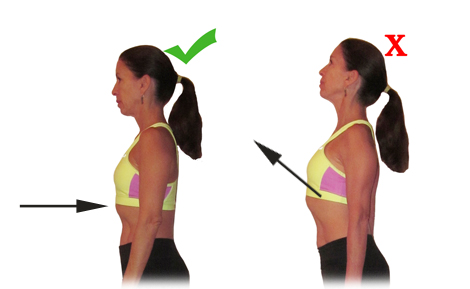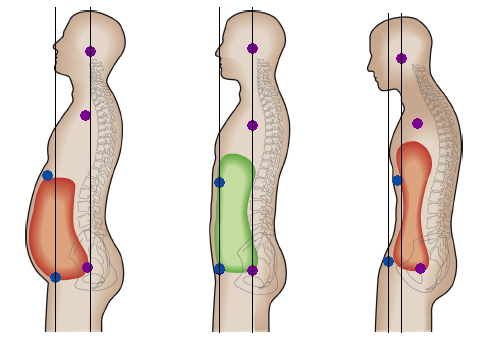Ah, posture. It’s something we have all been told to pay attention to and possibly “fix”, but it can seem daunting as most of us don’t know where to begin to fix it. Spoiler alert – throwing your chest out and squeezing your shoulder blades may not be the “best posture” for your pelvic floor anyway.

We know that most parts of the body have some connection, whether directly or indirectly, to other parts of the body and you may have heard that “what happens up the chain will affect down the chain” and vice versa. So, is that the same with the pelvic floor? Of course, it is! Let’s look at the literature to examine the effects of posture and pelvic floor function or pelvic floor dysfunction.
In a literature review by Zhoolideh et al. it was found that postural changes “may be seen more often in women with pelvic floor dysfunction.” Some of these postural changes included increased thoracic kyphosis (increased curve of the upper back), decreased lumbar lordosis (flattening of the lower back), increased contraction of the pelvic floor muscles (pelvic muscles that are working too hard), and increased protrusion of the shoulders (hunched position of the upper chest/ shoulders).1
However, a different study by Meyer et al. looked at the differences in thoracic and lumbar spinal curves between women with and without pelvic floor dysfunction (including incontinence and pelvic organ prolapse) and found no association between spinal curvature and pelvic floor symptoms.

By now you are probably thinking: “Sam! That doesn’t help me at all! Those are two conflicting studies – what or who should I believe?” The answer to that is a hard one and, as with everything, not black and white.
If you happen to have more of a flat lower back does that mean you will automatically have pelvic floor dysfunction? No. Does it mean that if you have “perfect posture” you will never have pelvic floor dysfunction? Also, no. That’s why looking at you as a whole person and taking multiple factors into consideration is so important. With that being said…
Your pelvic floor is an integral part of your core. We like to compare the core to a canister with muscles on the top (breathing diaphragm), bottom (the pelvic floor), front (deepest layer of abs, the transverse abdominus), and back (spinal muscles). We want all these muscles to have an equal “length-tension” relationship (meaning that they are not super contracted, nor are they in a stretched-out position) to ensure optimal functioning and leverage.
The optimal positioning or “perfect posture” for your pelvic floor health is where your rib cage is stacked directly over your pelvis (not flared out where your chest is stuck out and you are squeezing the daylights out of your shoulder blades). Your belly, butt, and pelvic floor should always be relaxed (unless you are actively working out and trying to recruit more core musculature).

You do not need to be thinking about this all day every day, in fact moving into and out of postures periodically is more beneficial than being stuck in one for a prolonged time. If you work at a computer a lot, try to break up the day and add in “movement snacks” by walking around, stretching, or even doing a couple of squats.
But the next time you do a jumping activity, try it with your chest sticking out and then try it with your ribcage stacked over your pelvis and you should feel more pelvic support, less pressure, and less leaking in the second position.
In conclusion, based on the core unit model, the pelvic floor and posture are related and important for pelvic floor functioning, but moving into and out of postures throughout the day is equally important when looking at the bigger picture.
- Zhoolideh P et al. Are There any Relations Between Posture and Pelvic Floor Disorders? A Literature Review. Cresent Hournal of Medical and Biological Sciences Vol. 4 No. 4, Oct 2017, 153-159. eISSN 2148-9696
- Meyer I, McArthur TA, Tang Y, McKinney JL, Morgan SL, Richter HE. Pelvic Floor Symptoms and Spinal Curvature in Women. Female Pelvic Med Reconstr Surg. 2016 Jul-Aug;22(4):219-23. doi: 10.1097/SPV.0000000000000271. PMID: 27054800; PMCID: PMC4919232.
* * *
Thanks for reading! If you’d like to learn more about who we are and what we do, click this link: https://upandrunningpt.com/

